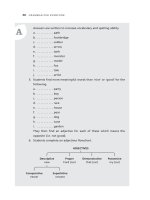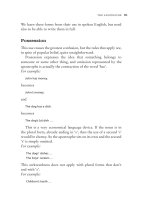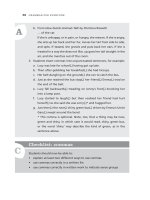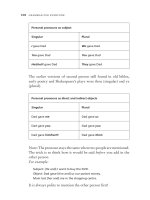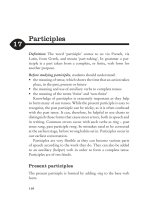Grammar for everyone part 15
Bạn đang xem bản rút gọn của tài liệu. Xem và tải ngay bản đầy đủ của tài liệu tại đây (113.55 KB, 7 trang )
C
A
b. From How Dumb Animals Talk by Christina Rossetti
… of the cat
If she is unhappy, or in pain, or hungry, she meows. If she is angry,
she sets up her back and her fur, moves her tail from side to side,
and spits. If teased, she growls and puts back her ears. If she is
treated in a way she does not like, up goes her tail straight in the
air, and she marches out of the room.
3. Students insert commas into unpunctuated sentences, for example:
a. Lucy was late for school(,) having got up late.
b. Then after gobbling her breakfast(,) she had hiccups.
c. Her belt dangling on the ground(,) she ran to catch the bus.
d. Just as she reached the bus stop(,) her friend(,) Emma(,) trod on
the end of the belt.
e. Lucy fell backwards(,) treading on Jenny’s foot(,) knocking her
into a lamp post.
f. Lucy started to laugh(,) but then realised her friend had hurt
herself(,) so she said she was sorry(,)* and hugged her.
g. Just then(,) the new(,) shiny green bus(,) driven by Emma’s Uncle
Gary(,) swept around the bend.
* This comma is optional. Note, too, that a thing may be new,
green and shiny, in which case it would read, shiny, green bus,
or the word ‘shiny’ may describe the kind of green, as in the
sentence above.
Checklist: commas
Students should now be able to:
• explain at least two different ways to use commas
• use commas correctly in a written list
• use commas correctly in written work to indicate sense groups
88
G r A M M Ar f o r e Ve rY o n e
Inverted commas
Definition: The marks consist of the comma shape, while ‘inverted’
refers to the opening pair being written upside-down.
Before studying inverted commas, students should know about:
• the punctuation forms discussed previously to this section
• the correct construction of a simple sentence
Sometimes teachers refer to inverted commas, or speech marks,
as 66’s and 99’s (note the use of the apostrophe here). This is a
good way to remind children which of the marks open speech and
which ones close it.
Direct speech is much easier for learners to write than indirect
speech, which necessitates the use of conditional tenses (see page
146), but it is very important that they learn this punctuation at
an early stage.
The best way to introduce young students to the use of inverted
commas is through reading passages of dialogue, pointing out the
way it’s done. Students then need to practise a conversation piece,
constructing it on the board together. Together they should look
at a passage of dialogue from a school text, discussing the use of
punctuation and the layout, noting that usually a new line is used
to indicate a change of speaker.
Traditionally, double inverted commas (hence 66’s and 99’s)
were used for speech marks. A quotation within speech would be
marked by one at either end.
For example:
“My favourite book is ‘The Goblet of Fire’, by J.K. Rowling,” answered
Julie.
13
89
A
Some modern texts choose to use these marks the opposite way
round, as in ‘My favourite book is “The Goblet of Fire”, by J.K.
Rowling,’ answered Julie. Either is correct, but teachers in an
education institution should agree on the form to be adopted.
13.1 Activities: inverted commas
1. Students insert the correct punctuation into sentences using direct
speech.
a. Dad said come quickly and you will see a goanna.
b. I can see it shouted Anna jumping up and down.
c. Shh don’t shout whispered Dad you’ll frighten it.
d. What are you all looking at called Gemma from the kitchen
window.
e. Hush mouthed Anna her finger to her lips it’s a goanna.
2. Students write a conversation they have had with one of the
following, remembering that for each new speaker, we start a new
line.
a. the shopkeeper at the corner store
b. a friend
c. a policeman
d. a favourite star or sportsperson
e. an astronaut
f. an uncle or aunt
3. Students are given a copy of a selected passage from a well-known
book, with punctuation omitted. They reconstruct the passage,
inserting punctuation. They then compare their version with the
original.
A suggested passage, from J.K. Rowling’s
The Philosopher’s Stone:
‘I want to read that letter,’ he said loudly.
‘I want to read it,’ said Harry furiously, ‘as it’s mine.’
‘Get out, both of you,’ croaked Uncle Vernon, stuffing the letter
back inside its envelope. Harry didn’t move.
90
G r A M M Ar f o r e Ve rY o n e
C
A
‘I want my letter,’ he shouted.
‘Let
me see it,’ demanded Dudley.
‘Out!’ roared Uncle Vernon …
Checklist: inverted commas
Students should now be able to:
• insert inverted commas into the correct place in given sentences
• write direct speech, correctly using inverted commas, commas and
other punctuation already learnt, including apostrophes
91
i n V e r t e d c oM M A s
Subject and predicate
Definition: The word ‘subject’ is from Latin sub meaning ‘under’
and ‘ject’ from jacere to throw – hence thrown under. The subject
is that which is under our attention, i.e. the person or thing that
we are talking about. The word ‘predicate’, also from Latin, means
pre, ‘before’, and dicate, ‘spoken’. It is something told to someone
about the subject.
The students are already familiar with the term subject, being
the person or thing that the sentence is about. Now is the time
to confirm this – subjects do something, be something or have
something.
Every sentence has two parts: the subject and the remaining
part which tells something about the subject, and is called the
predicate. Students should now learn the terms, and label sen-
tences accordingly, as well as indicating the parts of speech of the
individual words. This can be treated like a puzzle.
Firstly, some sentences should be labelled on the board with
student participation. Students can then be given time to practise
on their own in their grammar exercise books. Some sentences
should be given for homework to demonstrate independent
learning and accuracy. It is, as always, important for the work to
be corrected to detect misunderstandings and errors.
‘Parse’ is from the Latin word pars meaning ‘part’ and describes
the task we are doing when we divide a sentence to show how it
is made up.
14
92
